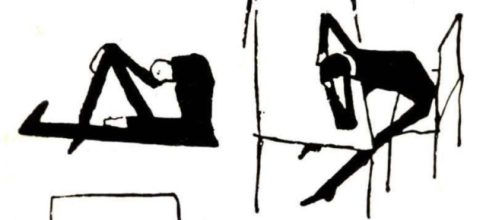Division of labor – the common economic principle that says workers assigned specific tasks do better jobs – should be applied to literary critics judging artwork in the new book “Franz Kafka: The Drawings.”
Lauren Christensen, senior staff editor on the books desk at the New York Times writes: “The figures he drew stand alone as stories in themselves.” No, they don’t.
Not everything a great man does is great
Instead, the drawings are small, random sketches of figures commonly found in how-to-draw books. Kafka doodled them in the margins of his diaries, letters, and notebooks when he was in law school.
He called them “scribbles.”
Unaccountably, Christensen disputes Kafka’s description saying the sketches are not scribbles. She’s one of several book reviewers stepping out of their lane. Consider David Herman, chief fiction reviewer for the Jewish Chronicle.
Herman called this book of commonplace drawings “a milestone in Kafka studies.” Waxing on, he said: “What is striking is how they depict human faces and figures with just a few strokes.”
No, what is striking is how conventional and un-Kafkaesque the drawings are for a writer known for the nightmarish novel about a man who wakes up as a giant insect – “Metamorphosis.”
Herman also found something else “striking” about these drawings: “How similar they are to the central themes of Kafka’s writing,” pointing out how “immobile the figures are sitting at a desk or on a chair.” He sees these as “trapped and trying to escape” – the very theme in “Metamorphosis.”
Did he say “immobile”?
“The expressions and postures are not static, but often dynamic,” says Andreas Kilcher, professor of literature and culture in Prague, who edited this book.
Kilcher calls the drawing collections “the last great unknown trove of Kafka’s works.” But I have to wonder if Kafka would agree. As he famously said, “A book must be the ax for the frozen sea within us.” There’s no within-ness in his cursory figure drawings.
Seeing things that aren’t there
Literary critic Judith Butler also ties Kafka’s drawings to his writing. In the book she says the way he drew his figures is the way he wrote about bodies.
Mind you, this literary crowd is talking about idle drawings retrieved from wastepaper baskets where Kafka tossed them.
His friend Max Brod saved them from the trash.
The rest of the 250-item collection Brod scissored from the margins of the course notes Kafka took at law school. Clearly, Kafka didn’t take his “scribbles” seriously. Before he died at age 40 of TB, he even asked Brod to burn them.
It follows that we shouldn’t get too carried away with Kafka’s “scribbles.” Are you listening, book critics? Certainly, Art in America art critic Jackson Arn kept it together when he saw this collection:
“It’s worth being blunt about the mediocrity of his drawings.” How mediocre, Jackson? “They throw the brilliance of the stories into sharper relief.”
What he said.


